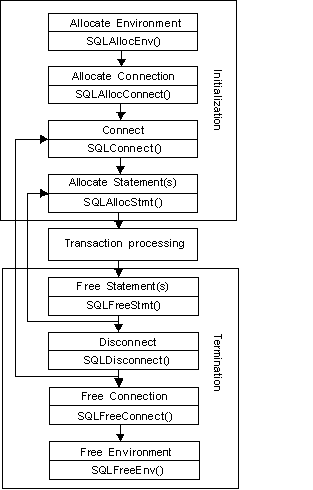The initialization task allocates and initializes environment handles and connection handles.
The following figure shows the function call sequences for both the initialization and termination tasks. The transaction processing task in the middle of the diagram is shown in Transaction processing task in a DB2 UDB CLI application.
The termination task frees handles. A handle is a variable
that refers to a data object that is controlled by DB2® UDB CLI. Using handles frees the application
from having to allocate and manage global variables or data structures, such
as the SQL descriptor area (SQLDA), or SQL communication area (SQLCA) used
in embedded SQL interfaces for IBM® Database Management Systems (DBMSs).
An application then passes the appropriate handle when it calls other DB2 UDB
CLI functions. Here are the types of handles:
- Environment handle
- The environment handle refers to the data object that contains global information regarding the state of the application. This handle is allocated by calling SQLAllocEnv(), and freed by calling SQLFreeEnv(). An environment handle must be allocated before a connection handle can be allocated. Only one environment handle can be allocated per application.
- Connection handle
- A connection handle refers to a data object that contains information that is associated with a connection that is managed by DB2 UDB CLI. This includes general status information, transaction status, and diagnostic information. Each connection handle is allocated by calling SQLAllocConnect() and freed by calling SQLFreeConnect(). An application must allocate a connection handle for each connection to a database server.
- Statement handle
- Statement handles are discussed in Transaction processing task in a DB2 UDB CLI application.
